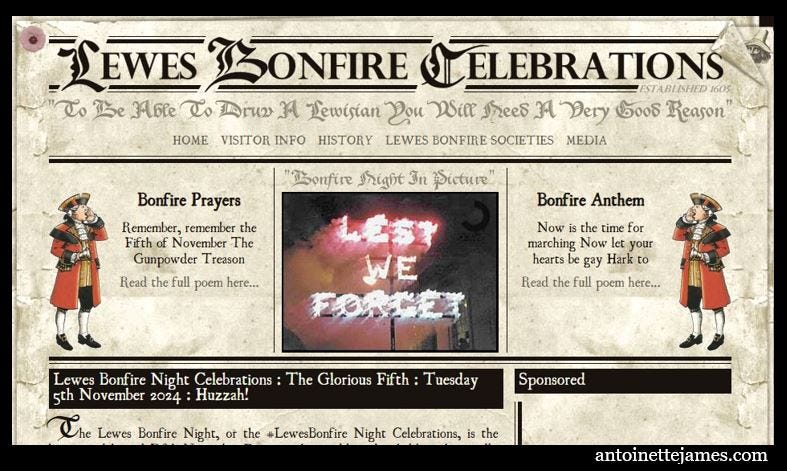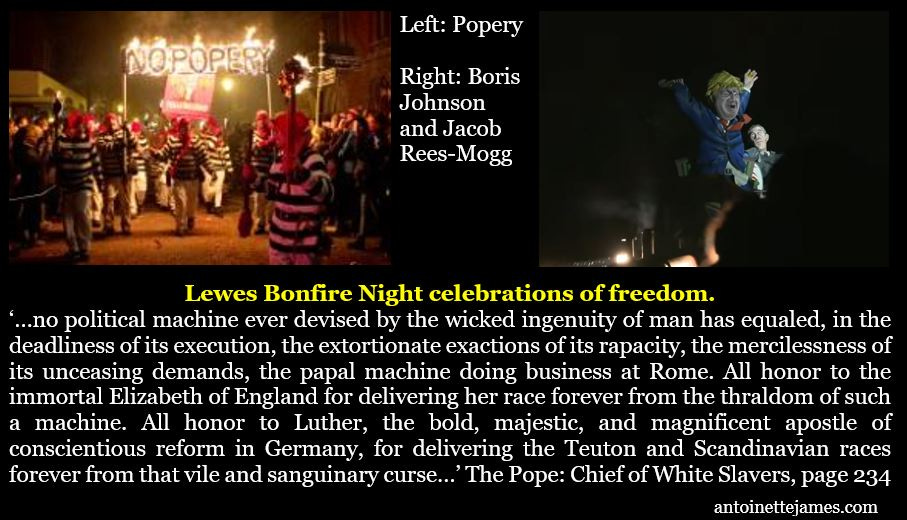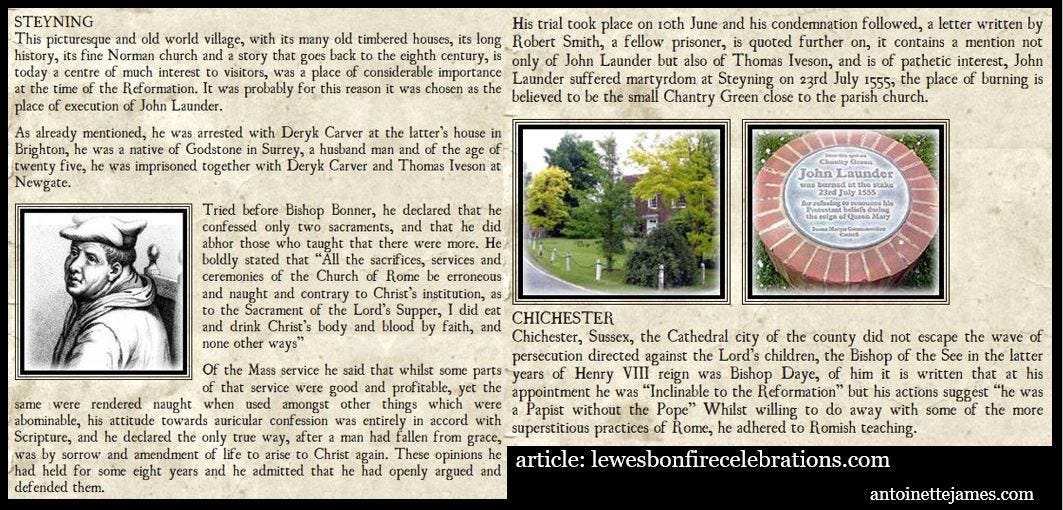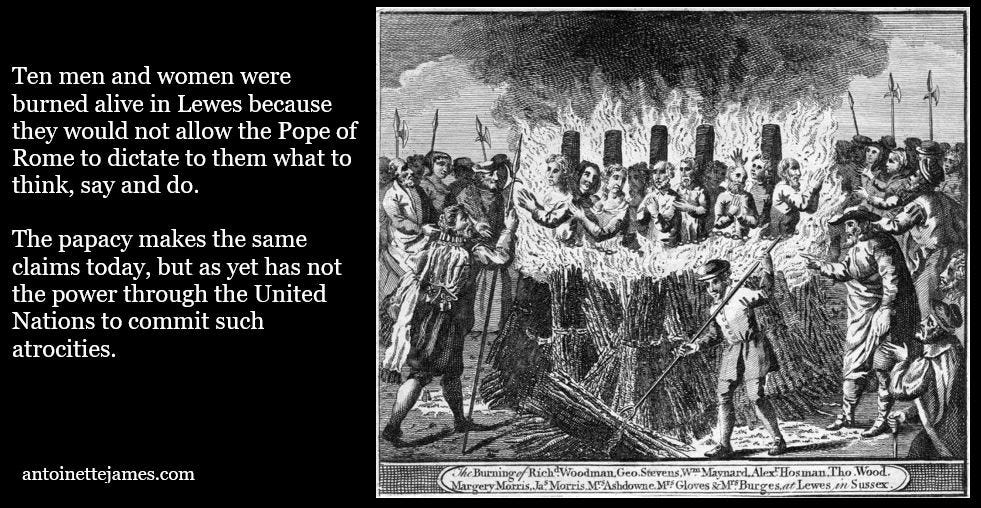Guy Fawkes-Bonfire Night celebrations in England have endured for over four hundred and twenty years. It was first celebrated after a decree of King James and parliamentary Act in England in 1606, a year after the Jesuit failed gunpowder plot. The Act designated the 5th November a day of thanksgiving to God for His deliverance.
(Guy Fawkes Gunpowder plot refer https://antoinettejamescom.substack.com/p/guy-fawkes-part-1)
In the mid-1900s Bonfire Night was starting to be erased by local council interference. This was coupled with a concentrated Vatican Led United Nations tasking of UNESCO (United Nations Educational Scientific and Cultural Organisation) to infiltrate minds of the young in schools. In turn this was coupled with UN Agenda 21 action in Councils as in the town of Lewes the heart of Bonfire Night in England.
‘Cliffe [Lewes Bonfire Society formed in 1893] has frequently had to overcome ‘behind the scenes’ difficulties. Premises to use for fundraising activities and preparing for the ‘Fifth’ became more difficult to find and the long-time firesite on Malling Hill ceased to meet increasingly stringent firework safety regulations. More recently new firework legislation and concern for crowd safety has prompted Cliffe to form its own firework company, increase co-operation with the police and emergency services and seek a permanent safe firesite. Since the 1970’s successive committees have worked strenuously, not only to raise the necessary funds to put on the best celebrations in the town, but also to accumulate sufficient funds to secure the long term future of the Society. In 1980 land and buildings were acquired to provide permanent premises, in 1983 the Society became legally constituted, becoming Cliffe Bonfire Society Limited and in 2003 Cliffe’s celebrations have been made secure by the purchase of its own firesite. Cliffebonfire.com
UNESCO was created a year after the UN, is commissioned with the express task to destroy Protestant culture in favour of the religion of subjective science, and to make indigenous cultures museum pieces in favour of the elite Luciferian globalisation.
Societies like Lewes’ Cliffe uphold 1605 English Protestants’ call to Remember. After all they witnessed how close they had come to losing all their God given inalienable rights by the hand of their Roman Catholic Queen Mary I, a papal mouthpiece.
In 1626, twenty-one years after the attempt to make a political and religious vacuum in England for the pope to quickly occupy, John Milton of Cambridge wrote a poem to immortalise God’s hand of deliverance. The poem, In Quintum Novembris (On the Fifth of November) was initially written in Latin and later translated to English. It was a hit as it spread around England. There were modifications made to suit the nuance of cultures, but the theme was the same – Triumph over papal intrusion. As the British Empire expanded opening up the Protestant West (USA, Canada, Australia and New Zealand), made up of Christians fleeing Papal Europe, Bonfire Night commemorations and poem followed.
At the beginning of the 1900s House of Rockefeller infiltrated many institutions, publishing being one of them. Jesuitical plots were edited out of school curriculum and Encyclopaedias like Britannica, while Roman Catholicism was given a benign makeover. This slow march through the Institutions has culminated in the ebbing of the knowledge of true history and therefore the understanding of why a few communities still commemorate Bonfire Night. The elite Big Corps UN NGOs have taken over many festivals secularizing their meanings to dilute their bearing on freedoms. Centralised fireworks displays often replace community gatherings turning participators mere passive observers. In some countries Guy Fawkes night has been removed from the calendar or worse it has been absorbed into the Roman Catholic Hallowe’en celebrations.
‘To this day, every November 5th the English Protestants, especially those in Lewes and Sussex who burn the effigy of the Pope annually, celebrate “Guy Fawkes Day” while the Jesuit Provincial at Stonyhurst controls the Archbishop of Westminster who in turn rules the country through the Royal Institute for International Affairs (RIIA), the British version of the American Council on Foreign Relations (CFR) likewise controlled by the Archbishop of New York. The Empires of both Britain and America are in the hands of Satan’s Society of Jesus!’ Vatican Assassins, 2001, Eric John Phelps, page 131
Remembrance has been left to remnant communities like the ancient Medieval town of Lewes, but Lewes has shed more blood at papal dictates than other towns.
‘The whole of Sussex is the heart of bonfire, but Lewis is the heart of the heart of bonfire’ Bonfire Night Participant in Lewes
In a strange way Bonfire night in Lewes, though diversified in theme, manages to retain some of the heart of the past. Modern day political figures are burnt but there is no fury in intent such is the lack of understanding by the indoctrinated masses.
‘The strongest Protestant regions of England, effigies of the pope were burned along with those of Guy Fawkes, and the holiday was known as Pope’s Night (other luminaries enjoyed the same privilege over history: effigies of the Old Pretender, Napoleon, Cardinal Weisman, Nan Sahib Kaiser Wilhelm II and Colonel Nasser were also burned in England).’ Halloween: An American Holiday, An American History, 1998, Lesley Pratt Bannatyne, page 15
Today, lack of history and vigilance has meant there is more frivolity and less earnest. But the Cliffe Society alone, through “persecution” has stayed true to truth.
‘There's seven societies they're all affiliated with different societies [affiliated to pubs] all have different colors that identifies them in each group have different things like they forgot Vikings and French revolutionaries and we're the only group who still burn the pope’ Bonfire Night Participate of Cliffe Bonfire Society
Journalism either wilfully or ignorantly sweeps over the threat to 17th century England, as easily as they sweep over the same threat to 21st century England. Commentator of JOE YT channel is an example of this when he understated the reason and the pope’s involvement saying, ‘Cliffe Bonfire Society [established 1853] burn an effigy of Pope Paul V in Lewis since the 19th century. Paul V was Pope at the time of the Catholic led gunpowder plot to assassinate the Protestant King James I, and although he didn't really have anything to do with it. I still get set on fire every single year’
Thankfully there are some history savvy people who are making sure people of today know how their freedom was secured.
‘It's important that I remind people why we're here and what we're doing. They just want to get on with the fireworks…’ Man dressed as a Protestant Bishop
Cliffe Society bring the sober side to England’s biggest fireworks night of fun and fancy dress.
‘At the Martyrs Memorial on top off Cliffe Hill, Cliffe president Paul Mockford laid a wreath while chairman Ric Newth gave an address. There followed a minute’s silence which was concluded by the firing of 17 maroons, one for each of the martyrs who died at Lewes.’ Sussex Express, Friday, July 29, 2005, www.sussexexpress.co.uk
Bonfire night is very personal for Lewesians who are not ignorant of papal decreed executions. Between 1555 and 1557 Lewes witnessed seventeen Protestant martyrs burned alive at the stake for not obeying the Papacy. In the 21st century priorities prevail so beheadings and burnings are not resorted to. However, agents of the papacy are very willing to imprison heretics who do not agree that the pope owns their soul.
The torturous executions were part of Roman Catholic Queen Mary I ascent to the throne. England on the death of young King Edward VI, had quickly put on the throne the protestant and very young Lady Jane Gray, while the Roman Catholics in court were putting Roman Catholic Princess Mary on the throne. Yet another faction were lobbying for Princess Elizabeth. Lady Grey was beheaded in 1554 after being Queen for a mere nine days, and Elizabeth was sent to the tower to be next.
Mary spoke of religious tolerance until her throne was secure. With the backing of Catholic Archbishop, Cardinal Pole, she burned Protestant heretics around her realm securing papal dominance. This time was known as the Marian (Catholic Virgin Mary) Persecutions. So violent was the persecution of Protestants that she earned the nickname Bloody Mary. Many Protestant Bishops including the Archbishop of Canterbury, academics and laymen were rounded up. Those who did not have their lives ended by flame, axe or sword, languished in gaol where pregnant women were left to deliver their babies alone and to live or die, alone.
October 1554, a Bible-reading was taking place in the home of one Dirick Carver, a brewer from Brighthelmstone (now Brighton) with John Launder, Thomas Iveson and William Veisey. Roman Catholic Sir Edward Gage, the High Sheriff of Sussex, had them arrested while they were praying. They were brought before the court of Bonner, the Bishop of London in Newgate, and forced to sign confessions of being heretics. In July the following year Carver, was taken to Lewes town centre and burned outside of the Old Star Inn (now Lewes Town Hall). His Bible was taken from him and thrown into a barrel on the wood pyre. The crowd were with him, calling out encouraging words and praying to God to be with him, strengthen him and his faith for the flame.
As Carver knelt to pray, he was man-handled and forced to climb into the barrel. Once in it he picked up his Bible tossing it into the crowd calling, Lord have mercy upon me, for unto thee I commend my spirit and my soul doth rejoice in thee! He died in the flames.
His Protestant Bible was kept and is now on display in Lewes Museum. His blood was smudged on many of the pages bearing witness to the injuries he suffered by his Catholic persecutors for the crime of freedom of thought that diverged from the narrative of the day.
On 6 June 1556, more Protestants were burned to death in Lewes. Thomas Harland a carpenter of Woodmancote, Sussex; John Oswald a husbandman also of Woodmancote; and turners Thomas Avington and Thomas Reed of Ardingly, Sussex. They languished in gaol for months repeatedly rejecting the Catholic Mass because of the belief that the bread and wine to be the literal flesh and blood of Christ, harking back to Pagan Roman roots of Ancient Mystery Religion. They also refused to attend a service in Latin. The Roman Catholic Church outlawed the Bible in the common tongue. For this they died, as did Whitcliffe in 1384 and Jan Hus in 1415.
On 22 June 1557, Richard Woodman along with George Stevens, Alexander Hosman, William Mainard, Thomasina Wood, Margery Morris, James Morris, Denis Burges, Ann Ashdon and Mary Groves were burned alive on a single stack of wood in the undercroft of Star Inn, Lewes (today the Town Hall) where they had been held. It was the largest human burning in England's history on the order of Edmund Bonner, Roman Catholic Archbishop of London.
Mary Tudor’s reign ended in 1588, where upon Queen Elizabeth I took the throne, and the papal persecutions ended. Elizabeth was called the Heretic-Queen who had many assassinations attempts and the papal Spanish Armada failed invasion.
‘Toward the close of the reign of Elizabeth, in a proclamation dated Nov. 16th, 1602, she says that "the Jesuits had fomented the plots against her person, excited her subjects to revolt, provoked foreign princes to compass her death, engaged in all affairs of state, and by their language and writings had undertaken to dispose of her crown.’ History of Romanism: From the Earliest Corruptions of Christianity to the Present Time, 1845, John Dowling, pages 602
So, the poem In Quintum Novembris (The Fifth of November) calls to remember remember. Hollywood has corrupted the gunpowder plot morphing the intent in movies such as V for Vendetta. The glorifying of Guy Fawkes as urban hero defers the treason from the papacy and their Jesuits.
(refer https://antoinettejamescom.substack.com/p/guy-fawkes-part-3 and https://antoinettejamescom.substack.com/p/guy-fawkes-part-3)
The full poem, although many communities changed some words, points the finger squarely at the papacy -
Remember, remember! The fifth of November, The Gunpowder treason and plot; I know of no reason Why the Gunpowder treason Should ever be forgot!
Guy Fawkes and his companions Did the scheme contrive, To blow the King and Parliament All up alive. Threescore barrels, laid below, To prove old England's overthrow.
But, by God's providence, him they catch, With a dark lantern, lighting a match! A stick and a stake For King James's sake! If you won't give me one, I'll take two, The better for me, And the worse for you.
A rope, a rope, to hang the Pope, A penn'orth of cheese to choke him, A pint of beer to wash it down, And a jolly good fire to burn him.
Holloa, boys! holloa, boys! make the bells ring! Holloa, boys! holloa boys! God save the King!
Hip, hip, hooor-r-r-ray! (C. 1870)
Other similar poems that were later written have the same familiar lines - But James, very wise, Did the Papists surprise, As they plotted the cruelty great; He [God] know‘d their intent, So Suffolk he sent To save both kingdom and state…Down with the Pope, and God save the Queen!
America was also under the treasonous hand of the papal Jesuit Order. Their Protestant Constitution was being attack subtilty from within. The Jesuit plot to blow up the British Parliament did not go unnoticed, and a version of Milton’s poem was written -
The Fifth of November, As you well remember, Was gunpowder treason and plot; I know of no reason Why the gunpowder treason Should ever be forgot.
When the first King James the septre swayed, This hellish powder plot was laid. Thirty-six barrels of powder placed down below All for old England's overthrow…
Pray madam, sirs, if you' something give, We'll burn the dog and never let him live. We'll burn the dog without his head, And then you'll say the dog is dead.
From Rome, from Rome, the pope is come, All in ten thousand fears; The fiery serpent's to be seen, All head, mouth, nose and ears. The treacherous knave had so contrived, To blow king parliament all up alive. God by his grace he did prevent To save both king and parliament.
Happy the man, and happy the day, That catched Guy Fawkes in the middle of his play. Match touch, catch prime, In the good nick of time.
Here is the pope that we got, The whole promoter of the plot. We'll stick a pitchfork in his back And throw him in the fire. Mummer's Poem In Newburyport, Massachusetts circa 1760 USA
The freedom of the West is at stake. As in 1605 so today the papacy believes the earth and all that is within it belongs to them. The Hegelian Dialectic is allowed to swing back and forth from Thesis to antithesis, but at the end of the day, whether gunpowder or drugs dissenters are being dispatched. Some of them are liberal Catholics which the Jesuits by oath are pledged to kill. The inadvertent death of faithful Catholics is of no account. They are the smoke screen.
‘But the Jesuit leader of the conspiracy found an unexpected difficulty amongst his followers…they asked what was to become of so many of their own faith who most certainly would be present at the opening of Parliament, and who must also perish. But the Jesuit would have his end, even if it needed to wade in the blood of his own people to attain it. He assured the unhappy men who hung on his word as on the word of God, that this' would be merely the usual fate of battle, that they might be obliged to attack a walled-in city and that many Catholics might suffer as well as the heretics whom they must destroy; and they were satisfied. The word of the priest was all that was needed to make crime a virtue.’ The Black Pope: The History of the Jesuits, 1871, M F Cusack (Formerly the Nun of Kenmare), page 334
After the gunpowder plot King James enacted through Parliament an oath of allegiance to England was created to test if the Roman Catholics primary stood for King and country or the Pope.
‘This oath [of allegiance to the king] produced some unexpected results, for it involved the King in his famous pamphlet war against the Papacy. He claimed that the oath was a civil affair of the allegiance of his subjects to their prince. But it was viewed at Rome as a spiritual matter, a device to impose denial of the doctrine of papal supremacy and to create heresy and schism…To take the oath, wrote Cardinal Bellarmine, was not so much to swear allegiance to the King as to abjure allegiance to the Vicar of Christ. Two briefs by [Pope] Paul V, who had succeeded Clement in 1605 and was far less inclined to moderation, denounced the oath and forbade the English Catholics to take it…it centred upon the pretensions of the Papacy in dealing with heretical princes: the power to depose them, to free their subjects from allegiance, to foster rebellion, invasion, even assassination as sanctions against rulers who had left the fold.’ James VI and I, 1967, David Harris Willson, page 228
Like Pagan Rome, Papal Rome will not rest until she once again has dominion over the earth.
‘The Cardinal (Manning, who was a Catholic first and an Englishman after) has frankly given the special reason why Rome desires to conquer England and subdue it. He says: " If ever there was a land in which work was to be done, and perhaps much to suffer, it is here (England); were it (heresy) conquered in England, it would be conquered throughout the world. All its lines meet here; and, therefore, in England, the Church of God must be gathered in all its strength." Cardinal Manning…commends the men who suffered justly for the Gunpowder Plot as true heroes, and holds them up, to the admiration of the rising generation.’ The Black Pope: The History of the Jesuits, 1871 M F Cusack (Formerly the Nun of Kenmare), page 276-277
In the 1950’s the Bonfire Council attached pre-conditions to Cliffe Society participation in the now Council controlled Bonfire Night Procession. The Society was only allowed to join if they removed visible reference to the pope. Cliffe stayed true to the call to remember by maintaining their independence.
‘…one of their confessors, the Jesuit Garnet, suffered for his share in the treason, it was pretended that a portrait of the sufferer was miraculously formed by his blood, upon the straw with which the scaffold was strewn ; the likeness was rapidly multiplied ; a print of the wonder, with suitable accompaniments, was published at Rome ; Garnet in consequence received the honors of beatification from the Pope, and the society to which he belonged enrolled him in their books as a martyr.' History of Romanism: From the earliest corruptions of Christianity to the present time, John Dowling, page 603
Remember!
Please share this article with people you know who like this type of exposé











